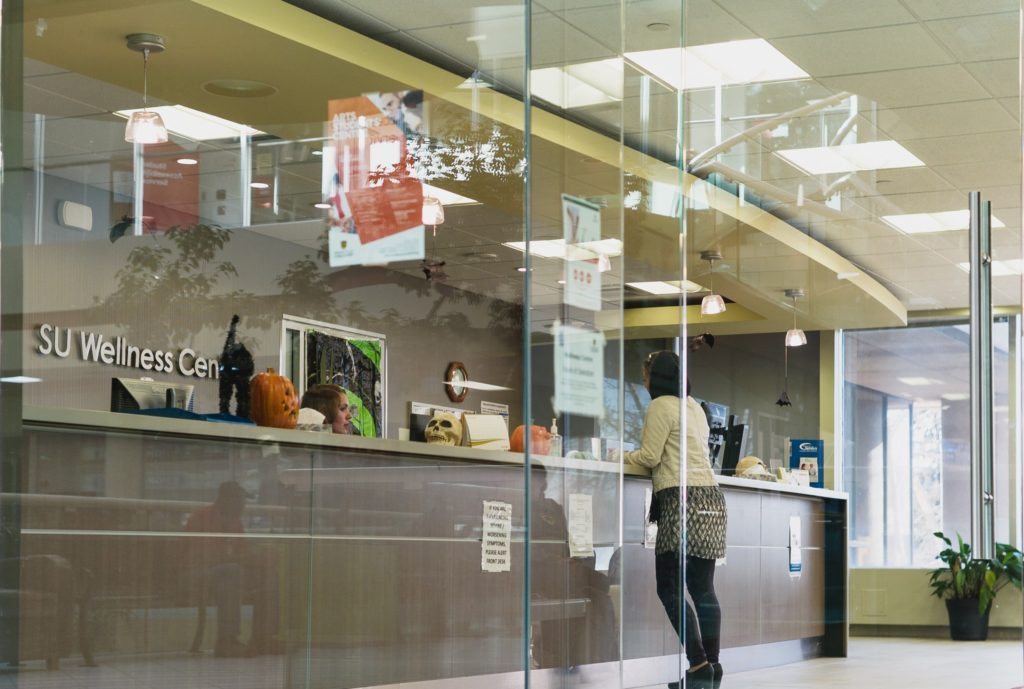
We need to talk about the Wellness Centre
By Gayathri Peringod and Krishna Shetye, August 10 2020 —
Some of the names of those involved have been changed to protect their privacy.
What exactly is going wrong, and why does no one seem to know?
Our best service, your best care.
This promise is what first drew Asha, a third-year psychology student to seek help from the Wellness Centre. A while ago, she had called the Centre — which offers both mental and physical health services — and set up an appointment, explaining that she wanted counselling support to help address questions about her past relationships. She sat in the Wellness Centre’s waiting room, filling out an extensive form of questions about her concerns, and was told that she would meet a mental health professional to assess her needs and recommend next steps.
Asha was then introduced to an intake employee who told her that while they were here to listen to her as a support advisor, they were not a licensed counsellor. She went through her concerns once again. They responded, politely, that she needn’t be worried that this was necessarily a mental health concern. They recommended that if her concerns persisted, she should go to their upcoming group mental health workshop about relationships, and gave her their card with an email address to contact if she wanted to make another appointment.
Asha put the card in her bag and walked away from the office, feeling exposed and slightly embarrassed that she had gone through the whole process with little to show for it. It was her first and last appointment with the Wellness Centre.
After digging deeper, we found out that many others had similar experiences. A February poll conducted on the popular Instagram page UofConfessions indicated that thousands of UCalgary students did not believe that the University of Calgary was currently doing a good job of taking care of student mental health. Although 86 per cent of respondents said that they struggled with their mental health, only 30 per cent said that they had gone to the Wellness Centre to seek help. Of those who did go, 83 per cent said that the Centre did not help improve their mental well being.
On a gamble, we asked the UCalgary Reddit community to share their experiences with the Wellness Centre. The responses were, again, overwhelmingly critical of the services provided. Many commenters mentioned their chagrin at being referred to group therapy rather than getting the individual help they desired, and many others lamented the limited resources allocated to them during their time of need.
“I went to the wellness centre [sic] once in [my] first or second year,” said one Redditor. “I couldn’t even take the bus to school without being filled with dread. I went to them and said I had mad social anxiety, and you know what they put me in? Group therapy. Needless to say, it didn’t help much.”
“I was in the EXACT same situation,” another Redditor chimed in. “I attended the group, hated it, so I went back to the wellness center [sic] after and they said they’d pair me up with a counsellor but that it could take up to 6 weeks … They literally never contacted me. I’m lucky because it turns out I have access to mental health services through my mom’s work but honestly I don’t know what would’ve happened to me otherwise. They completely let me down.”
On Reddit is where we met Dylan, a full-time student at the Cumming School of Medicine. When he first knew he needed help, he was dealing with a great deal of stress academically and personally.
“At the time I felt like I didn’t have any support system. I couldn’t talk to my family and I didn’t really have any friends so most of the time, I just suffered alone,” he said.
Dylan said that he even got to the point where he called the Distress Centre. Unfortunately, none of his strategies worked.
“It just felt like my counsellors were not making efforts to get me to open up more and were very passive. I wanted them to make efforts to get to know me as a person and in doing so, figure out the ways in which I was damaging myself and definitely still am.”
Another frequent complaint was that the Wellness Centre had long waiting lists for services which limited their accessibility. Dylan said, “The waiting lists for mental health services are very long and program schedules also run on one time slot from what I’ve seen. So if your schedule doesn’t match the program time slot, you’re out of luck.”
How did we get here? The answer seems to evade those involved with the Wellness Centre. Woods Homes, a local nonprofit that operates as the after-hours service for the Centre, suggests that the problem may be due to a lack of funding. However, Wellness Centre director Debbie Bruckner did not cite this as being an issue, stating that the Wellness Centre’s resources are only overwhelmed at peak periods.
Bruckner has been operating the Wellness Centre since its birth fourteen years ago. When informed of the current state of student dissatisfaction, Bruckner did not seem surprised.
“When I was doing student consultations, I heard [concerns about the wait time] loud and clear.”
Following the 2014 Brentwood stabbings that resulted in five dead — the person deemed responsible a recent U of C grad — Bruckner and the UCalgary administration launched the Campus Mental Health Strategy in 2015. The strategy was touted at the time as an initiative aimed to tackle the rising concern of declining student mental health support.
The launch came two years after the U of C participated for the first time in the National College Health Assessment. Its results, along with the 2014 stabbings, demonstrated that declining student mental health was rapidly becoming a serious concern.
The NCHA revealed that in 2013, 90 per cent of UCalgary students reported feeling overwhelmed by all they had to do, 64 per cent felt lonely, 58 per cent felt overwhelming anxiety and 67 per cent were very sad at some point within the last 12 months.
Interestingly, although 2016 NCHA results revealed that student mental health was still declining, the 2013 results were the last on which the administration publicly vowed to take action.
According to our own polls discussed above, these numbers have not improved since.
Why is this happening?
One thing that we noticed through our interviews is that no one really seems to know why Wellness Centre services do not effectively improve student mental health. Discussions with UCalgary faculty and staff suggest that the broader administration’s impression is that the Wellness Centre’s services, though well-intentioned and effective, are overcrowded and underfunded. Students’ general impressions also align with this logical explanation; students seeking Students’ Union positions even ran on this assumption in the 2020 SU general election.
This belief may come from the assumption that the newly elected United Conservative Party provincial government was hesitant to fund mental health services. However, according to Bruckner, the Wellness Centre’s annual budget of around $2 million dollars has been met since 2012.
This budget comes from government-allocated university funds, revenue from Wellness Centre services, project funding (including the Post-secondary Mental Health Grant) and a smattering of other sources including the SU Quality Money grant.
Bruckner did not expressly agree with the assessment that the Centre was overwhelmed and underfunded. When asked whether the Centre was overwhelmed, Bruckner stated that while all postsecondary mental health facilities experience higher demand than their capacity, the U of C’s Wellness Centre only felt overwhelmed during peak periods — according to a 2019 progress report for the Campus Mental Health Strategy, the 2018-2019 year saw each counsellor managing around four appointments on average on a given working day.
Similarly, when asked about funding, Bruckner pointed to the largely stable annual budget, which mostly went into staff salaries including both the mental health — the ten counsellors, the seven social workers (intake specialists) — and health staff that operate the mental health wing of the Wellness Centre.
If the Wellness Centre is not constantly overwhelmed or underfunded, as our interview with its director appears to suggest, it begs the question: What exactly is going wrong, and why does no one seem to know? The conflicting opinions of the various parties about the Wellness Centre’s operation only confuse the search for a solution.

What exactly is going wrong, and why does no one seem to know?
In response to the student concerns brought to her, Bruckner responded by highlighting the numerous efforts by the Centre to improve student mental health, citing newsletters, group programming and events dedicated to student mental health.
Students’ Union vice-president student life Assad Ali Bik was largely concurrent with this view. In Ali Bik’s opinion, the Wellness Centre is successful in meeting the needs of students that go to seek help. The Wellness Centre director has been consulting Ali Bik on a monthly basis to communicate student concerns as he understands them.
“[In the meetings], I provide insight from what I’m hearing from the student body,” Ali Bik said. “When I take these ideas to the director, they tell me, ‘Oh, we already have these events.’”
One reason for why Ali Bik may not have known about these events is that students in general are largely unaware that these events take place. In this regard, both Bruckner and Ali Bik recognize that mental health services could be more accessible.
“They have a lot of good things, and they have a lot of things that students are looking for,” said Ali Bik. “However, the awareness level is very low.”
A more short-term approach that may help tackle some of the wider issues surrounding the accessibility and effectiveness of mental health services may be one that more directly involves students.
Bruckner does not seem opposed to incorporating student input into the Wellness Centre’s model, saying, “Honestly, I’m really open [to] ideas, because we feel like we use all the options [we have].”
So what can students do?
There appears to be some concrete ways the students can offer mental health support for each other. The Wellness Centre has an under-utilized Community Helpers program with over 600 volunteers who can offer peer support. According to Bruckner and Ali Bik, there are a host of unutilized services that the Wellness Centre offers, citing the drop-in Peer Listeners program as an example. A student marketing initiative for such services may help students seeking support from all parts of the mental health spectrum, as well as increasing student engagement in the mental health community.
Ultimately, it appears that the students may have to assist each other to improve student mental health the way they see fit. However, it may occur to some that this responsibility is not necessarily the students’. The university has a mandate to use its available resources to provide services that successfully fulfill the needs of its students, including their mental health needs. Student testimony has clearly communicated the large discrepancy between the clients and providers of mental health services. It has also communicated the need for transparency and accountability in how those services are delivered.
“Our best service, your best care,” the Wellness Centre’s webpage states. From what we have seen, however, the students do not seem to agree. According to students, the Wellness Centre has fallen short in adequately responding to their concerns. Bridging the gap between students and the Centre may be the first step towards finding a lasting solution to the issues it faces. If the gap goes unaddressed, however, student mental health may have to bear the brunt of the consequences.
This article is part of our Features section and does not necessarily reflect the views of the Gauntlet’s editorial board.
